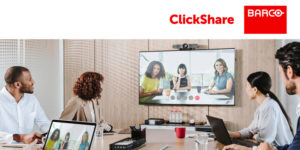
As the world continues to adjust to abruptly changed working conditions and many embrace video collaboration tools for the first time, experienced providers of collaboration technology are already looking further ahead. That’s because their clients, the IT buyers, also have to take a long view. And if some have suffered from a lack of remote-readiness due to the suddenness of the global health crisis, they’re determined to ensure effective resilience going forward.
Right now they’re dealing with urgent and pragmatic decisions to support their workforce, and this may mean allowing a bit more flexibility and uncertainty than the average CIO would choose to have in their lives. Provisioning remote desktops on whatever computer someone might have sitting at home might be the only option, or enabling people to work on mobile and tablet devices never really intended for the business world. Whatever it takes, to keep the world working.
But executives are resourceful too and finding their own solutions to their needs. With an avalanche of cloud service providers and a slew of offers and free trials in their inbox while they wait for tech to get back to them, shadow IT has exploded like never before.
Bring Your Own Meeting
That’s going to have consequences when these people go back to the office, explained Barco’s Workplace Marketing Director, Lieven Bertier, citing recent research they conducted with knowledge workers in the US and Europe (prior to the health crisis) which showed that people regularly carried 2 or 3 communications devices into office meetings anyway, and switched around between up to 6 different platforms through the day:
“I may start the day in Zoom, next up it’s Webex, then maybe my next meeting is in Bluejeans… So we see people hosting meetings from their own device. But they may be in a meeting room which has great huddle features, like Logitech Rally…” he explains. “ClickShare means you can mirror your device on the meeting screen, or use the Yamaha camera.”
Barco developed ClickShare in 2012, when this nascent trend generally meant a horrible mess of incompatible cables. Since then the award-winning product has evolved to make it even easier for people to bring whatever hardware or software they feel most at ease with into any meeting.
So when the world goes back to ‘normal’ — which for some people at least will mean returning to a central office building — the need for interoperability of this nature will be even stronger. As Bertier continued, “the expectation of doing everything from your own device will be strengthened, because all of us are used to hosting calls from our own laptop. We’ll take that new normal back into the office with us. And the question is of course going to be, if the conversation is no longer one to one, how am I going to deal with that?”
A blended and hybrid workspace of the future
With applications like Clickshare to bridge the gap between tools and devices, and perhaps smaller and more activity-focused work spaces and meeting rooms, a fluid future of collaboration is what Bertier envisages:
“The digital workplace is all about bringing the ease of consumer technology into the workplace so people can work better together, and just have great experiences. Nobody wants to read a manual, nobody wants to be trained… you just start using it.”
“That’s what we’ll all expect, when we go back to the office”
from UC Today https://ift.tt/2z7Vn2l





0 Comments